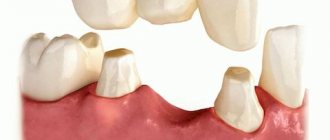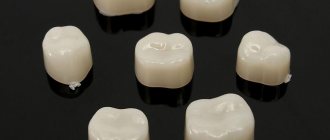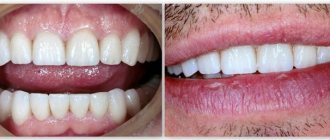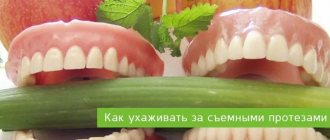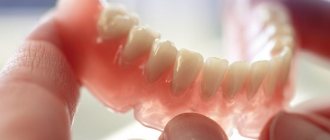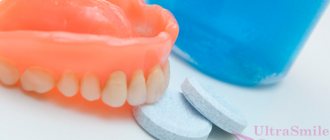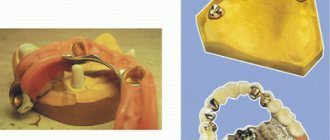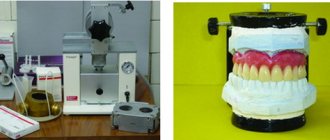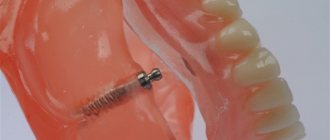Children's dental prosthetics is an opportunity to quickly restore a damaged, lost or missing primary or permanent bite unit. The dental procedure takes 20-40 minutes and is suitable for children of almost any age.
Any tooth loss before the child reaches 6 years of age is considered abnormal and requires urgent solution to the problem.
The lack of timely prosthetics leads to problems with chewing and speech, and provokes the development of bite pathologies.
Why does a child need dentures?
Many parents think that there is nothing wrong with a child missing several teeth until the permanent ones appear. However, ignoring the problem leads to dysfunctions of the child’s body:
- difficulties in sound pronunciation. The teeth are involved in the formation of sounds, the child will adapt and after the radical elements grow, he will begin to pronounce words incorrectly - a speech defect is obvious;
- gastrointestinal diseases - poorly chewed food, injures the mucous membrane of the organs of the system, leads to the development of local diseases, poor absorption of useful components;
- malocclusion - when a child loses a tooth early, other chewing units take its place, the molar has nowhere to grow - it grows out of the row. The result is that a malocclusion is formed, an aesthetic defect and psychological discomfort appear.
A dental prosthesis for a child is designed to temporarily replace the missing element and help avoid unpleasant consequences.
When is prosthetics indicated?
Dental prosthetics in children is carried out under the following circumstances:
- the tooth is affected by caries and cannot be restored;
- the element has broken off at the level of the base, root;
- tissues affected by fluorosis;
- bone inflammation has been diagnosed, in which tooth extraction is inevitable;
- periodontitis has been identified as the cause of unit mobility;
- the child has bruxism;
- the patient has underdeveloped enamel or other local congenital pathologies.
Varieties
Based on the operating characteristics of the device, there are two categories of prophylactic prostheses:
- Removable designs – they are simple and comfortable to wear, but if not fitted correctly they cause discomfort during mechanical loads on the department;
- Fixed models are a more practical option, which, however, requires careful compliance by the patient with hygienic standards for oral care.
Types of children's dentures
Depending on the transferred functions (purpose), a children's denture for baby teeth can be removable or non-removable.
Removable prosthetics
The defining characteristic of the products is the ability to remove the structure without the help of a doctor, if circumstances so require. They are made from a homogeneous material or several are combined. In the practice of pediatric dentistry the following is used:
- bridge prosthesis. Needed to replace defects of considerable extent (3 or more). Typically, the product is made from different types of plastics. It is possible to use metal to create fixing elements or individual parts of the structure;
- plate prosthesis. The product consists of a plastic base and fasteners. It can be stationary or sliding. The same type of structures is effective in orthodontic therapy in correcting bite pathologies and aligning individual elements in a row;
- immediate prosthesis or “butterfly”. One-piece thermoplastic nylon base structure. This is a crown, complemented by clasps that “cling” to adjacent units and fix the prosthesis in place. Typically, such a design is installed if a child has lost one “milk jug” due to injury.
Fixed prosthetics
Fixed dental prosthetics for children is important in cases where partial defects need to be restored (the child’s tooth remains in place). We are talking about products such as:
- tab. Fixed orthopedic structures help to “resurrect” the destroyed tooth crown while preserving the pulp and tooth root. In other words, this is a volumetric filling that replaces the destroyed part of the tooth, preserving the anatomical shape of the unit;
- pin tab. Installation of a prosthesis is indicated when the nerve is damaged and its resection is necessary, as well as when the crown is almost completely destroyed and the root is preserved. The doctor fixes the pin carefully, without damaging the thin root walls. The pins are made of chromium-nickel or gold alloys, the crown is “finished” with porcelain or plastic facets;
- crown. A metal structure that replaces the crown part of a decayed tooth. In this case, chromium-nickel alloy or medical steel is used;
- Strip crown is a transparent product. It is used for injuries, carious lesions, and bruxism. The “cap” is made of transparent acrylic; the filling composition plays a secondary role.
Crowns
Like all children's orthopedic structures, they can be of two types:
- Permanent.
- Temporary.
The latter can be fixative or preventive. They are used when a corner or cutting edge of a tooth is broken off as a result of trauma, to fix the therapeutic material. They are also used to fix devices for various dental defects to prevent tooth displacement.
Important! When performing prosthetics with temporary crowns, tooth preparation is not performed.
Crowns are used in the following cases:
- Bruxism (teeth grinding at night).
- Restoration of permanent teeth after enamel damage.
- Restoration of carious teeth.
- Tooth restoration after pulp removal.
- Complete destruction of the tooth by caries.
- Dental injuries, etc.
What should prostheses be like for children?
Children's dental prostheses must meet increased requirements, namely:
- do not interfere with the formation of children's speech and diction;
- be aesthetically pleasing and extremely easy to use;
- do not cause allergies, do not have a toxic effect on the child’s body;
- do not injure the oral mucosa;
- have minimal shrinkage and swelling;
- be resistant to plaque formation.
It is not always possible to eliminate all the negative effects of prostheses on the child’s body. In such cases, they make a choice in favor of those products that cause minimal damage.
Progress of prosthetics
Regardless of the type of prosthetic structure, the procedure includes the following steps:
- examination, consultation;
- diagnostics - conduct a survey, examine the child (take an x-ray);
- preparation for fixation of the prosthesis. If necessary, treat the tooth;
- taking impressions;
- product production;
- fitting and installation of the prosthesis.
Before fixing any type of product, general preparation of the unit is required - organizing professional cleaning of the enamel layer.
Cost of services
| Initial appointment with an orthodontist | 1,000 rub. |
| Initial appointment with an orthodontist with a photo protocol | 1,650 rub. |
| Preventive appointment (examination, consultation) with an orthodontist | 1,000 rub. |
| Orthodontic correction (fixed inclined plane) | 5,000 rub. |
| Orthodontic correction (determining the type of closure using a facebow) | 12000 rub. |
| Orthodontic correction (preventive treatment of tooth enamel at the stages of treatment and after removing the braces) | 1,500 rub. |
| Orthodontic correction (separation of 1 tooth) | 500 rub. |
| Orthodontic correction (removal of 1 bracket) | 600 rub. |
| Orthodontic correction (removal of braces from 1 row of teeth) | 8,000 rub. |
| Orthodontic correction (removal of lingual braces from 1 row of teeth) | 11250 rub. |
| Orthodontic correction (removal of a wire retainer from 1 row of teeth) | 3,500 rub. |
| Orthodontic correction (taking impressions, making diagnostic models) | 5,000 rub. |
| Orthodontic correction (installation of a device for the treatment of distal occlusion) | 3,000 rub. |
| Orthodontic correction (installation of an opening spring) | 1,200 rub. |
| Orthodontic correction (fixation of the bracket system on 1 row of teeth, category 1 complexity) | 40,000 rub. |
| Orthodontic correction (fixation of the bracket system on 1 row of teeth, category 2 complexity) | 50,000 rub. |
| Orthodontic correction (fixation of the bracket system on 1 row of teeth, category 3 complexity) | 60,000 rub. |
| Orthodontic correction (fixation of brackets for 1 tooth) | 2,500 rub. |
| Orthodontic correction (fixation of a lingual brace system for 1 row of teeth) | 50,000 rub. |
| Orthodontic correction (fixation of a non-removable wire retainer for 1 row of teeth) | 10,800 rub. |
| Orthodontic correction with a fixed orthodontic appliance (lingual arch, palatal clasp, lip bumper, ring with spacer) | 8,000 rub. |
| Orthodontic correction with a fixed orthodontic appliance (fixed expansion appliance) | 35,000 rub. |
| Orthodontic correction with a fixed orthodontic device (fixed orthodontic device used with a brace system) | 22,000 rub. |
| Orthodontic correction with a fixed orthodontic appliance (fitting, fixation of the bandage ring) | 1,500 rub. |
| Orthodontic correction using bracket systems (replacement of the arch, bending on the arch, replacement of elastic traction on 1 row of teeth) | 6,000 rub. |
| Orthodontic correction using bracket systems (replacement of the arch, elastic traction on 1 dentition, lingual technique) | 3,700 rub. |
| Orthodontic correction using bracket systems (replacement of the arch, elastic traction on 1 row of teeth, individual lingual technique) | 7,000 rub. |
| Orthodontic correction using bracket systems (arch replacement) | 5,000 rub. |
| Orthodontic correction using braces (individual lingual braces for 1 row of teeth + Set Up) | 70,000 rub. |
| Orthodontic correction using braces (correction of braces) | 5,000 rub. |
| Orthodontic correction using braces (correction of a wire retainer, more than 3 teeth) | 5,000 rub. |
| Orthodontic correction using braces (correction of a wire retainer, up to 3 teeth) | 3,500 rub. |
| Orthodontic correction using braces (lingual braces for 1 row of teeth + Set Up) | 65,000 rub. |
| Orthodontic correction with a removable orthodontic apparatus (single-jaw with screw and additional elements) with 3 screws | 20,000 rub. |
| Orthodontic correction with a removable orthodontic appliance (double-jaw with screws) | 25,000 rub. |
| Orthodontic correction with a removable orthodontic apparatus (correction, activation of a removable plate apparatus) | 2,000 rub. |
| Orthodontic correction with a removable orthodontic device (treatment with transparent aligners of the 1st category of complexity, Star Smile) | 125,000 rub. |
| Orthodontic correction with a removable orthodontic device (treatment with transparent aligners of the 1st category of complexity, Invisalign Light) | 350,000 rub. |
| Orthodontic correction with a removable orthodontic appliance (treatment with transparent aligners of category 2 complexity) | 250,000 rub. |
| Orthodontic correction with a removable orthodontic device (treatment with transparent aligners of category 2 complexity, Invisalign Full) | 450,000 rub. |
| Orthodontic correction with a removable orthodontic device (Myobrace system), selection of type, observation for 1 year | 15,000 rub. |
| Orthodontic correction with a removable orthodontic apparatus (single-jaw with screw and additional elements) | 17,000 rub. |
| Orthodontic correction with a removable orthodontic appliance (positioner) | 17,000 rub. |
| Orthodontic correction with removable orthodontic apparatus (repair of removable plate apparatus) | 4,000 rub. |
| Orthodontic correction with a removable orthodontic apparatus (simple removable plate apparatus) | 9,000 rub. |
| Orthodontic correction with a removable orthodontic apparatus (retention mouthguard, 1 dentition) | 7,000 rub. |
| Orthodontic correction with a removable orthodontic apparatus (removable retention plate apparatus for 1 jaw) | 10,000 rub. |
View all
*Prices do not include the cost of the braces system.
Why is it safe to install children’s prostheses in Stokos?
The Stokos Clinic in St. Petersburg works tirelessly to ensure that young patients and their parents feel calm and comfortable within our walls. Our doctors are trusted because with us:
- reliable. Stokos Dentistry employs experienced, certified doctors who approach business wisely and never act according to a template;
- calmly. Our dentists know how to make the child comfortable with themselves and the process - parents do not have to worry about their child;
- comfortable. Our staff is always polite to those who contact us, smiling and prompt in taking action;
- inexpensive. We set fair prices for services.
Make an appointment with our doctor right now - because here, with us, sincere smiles are born!
